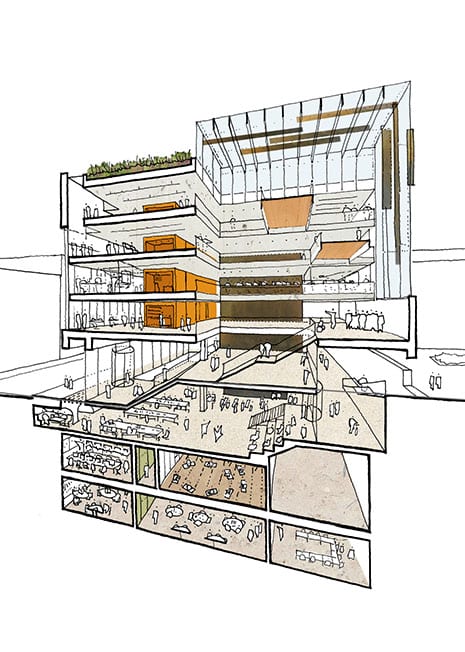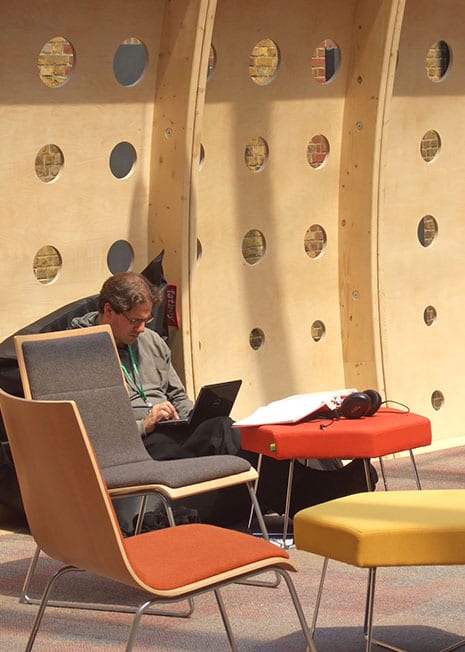RSA Event, Winchester
Date posted: November 15, 2013
On Thursday 14th November Directors Rupert Cook and Nick Mirchandani gave a presentation and led a discussion as part of the RSA’s Ideas in Education series.
As a practice that has specialised in education design for over 30 years, ArchitecturePLB is well placed to identify trends in the educational rational underpinning new learning environments. During this event we wished to offer our own observations and explore with our guests the possible implications of a recent divergence in the way in which educational buildings are briefed.
With a portfolio that spans the age range from early years to higher education, we had noticed over the last 10 years that schools, colleges and universities were increasingly concerned with some of the same issues, in particular:
– The individualization and ‘personalisation’ of learning based on a recognition that different students learn in different ways and that flexible buildings offering a range of spaces are needed to support varied learning activities and group sizes.
– ‘Student experience’, in particular a new emphasis on the importance and quality of social spaces as well as teaching and learning spaces.
– A recognition that learning and socializing are not distinct and separate activities but that learning can and should occur in a variety of settings including spaces for ‘social learning’ as well those for traditional didactic teaching and private study.
– A changing relationship between ‘teacher’ and ‘student’ (due primarily to the speed of technological change and the need for all members of society to be continual learners) to one of ‘experienced and inexperienced learners’.
– A blurring of the boundaries between traditional subjects and a wish for the physical environment to facilitate and encourage inter-departmental activity.
– The wish to create or develop an institution’s individual identity and character as an important differentiator in an increasingly competitive market for education.
Since the abolition of the Building Schools for the Future programme and the publication of the James Review in 2011 however, the briefing of schools has changed dramatically. While colleges and universities continue to explore and respond to the issues described above, the briefing of school buildings has become increasingly centralized and standardised, with a presumption in favour of traditional, cellular classrooms.
Representing a wide range of interests in education, we invited our guests to form smaller groups in order to debate three specific questions:
1. Are our observations borne out by your own experience?
2. What, if any, are the likely implications?
3. What of the future?
While the debate was wide-ranging, there was general consensus amongst all groups that these changes are indeed evident and that the implications are potentially significant. Much of the debate focused on the risk of a gap between the learning skills expected by further and higher education providers (particularly in self-directed learning) and those with which schools equip their leavers. There was agreement that if ‘learning to learn’ becomes a lesser priority for schools then further and higher education providers may need to fill the gap themselves, possibly as a kind of ‘foundation course’ similar to Art schools.
Of even greater concern were the implications for those students who do not go on to further and/or higher education. If they are to leave school with knowledge but without core learning skills then there is a serious risk that they may be ill-equipped to continually develop themselves as required in today’s workplaces.
With regard to the future, there were both optimistic and pessimistic voices. Some felt that recent changes in school briefing reflected the state of the economy rather than a more fundamental diversion from a wider trend. It was also noted that school age students are becoming more demanding consumers of education and would themselves apply pressure to maintain and improve the delivery of learning skills.
The more pessimistic noted that the UK is now in a global market for education and that if further and higher education providers fail to find the learning skills they require from ‘home grown’ students then they would be increasingly likely to seek higher caliber candidates abroad. Alternatively some guests felt that further and higher education providers would seek to extend their provision to younger students. ArchitecturePLB’s own experience supports this suggestion, including a further education college sponsoring academies, a free school and a ‘studio school’ as part of a federation and university involvement in schools through UTC’s.
With both positive and negative possibilities, the greatest concern appears to be a risk of increasing inequality in school-age provision. This of course would be entirely contrary to the intentions behind a more standardized approach.




